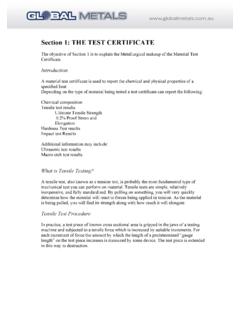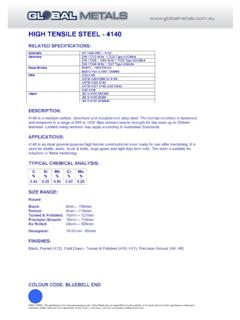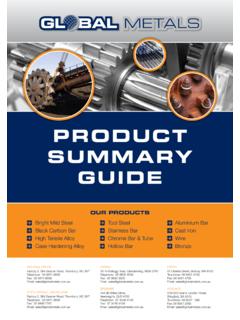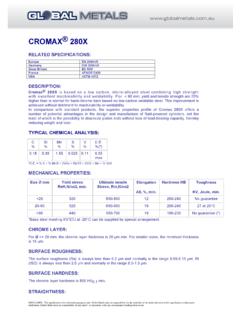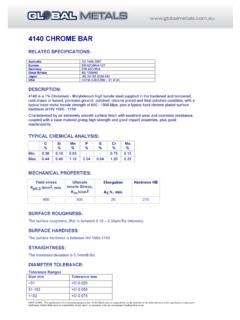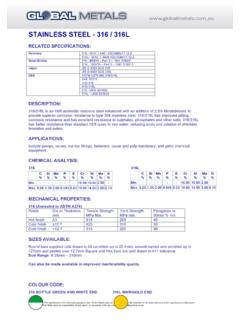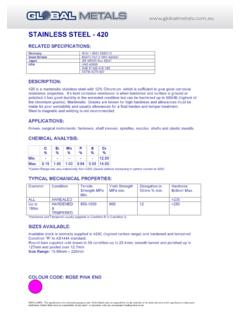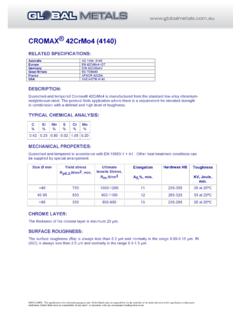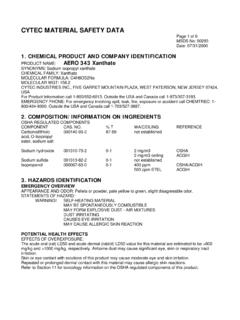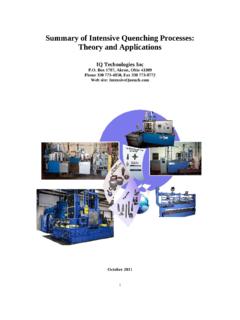Transcription of Section 4: EFFECTS OF ALLOYING ELEMENTS
1 Section 4: EFFECTS OF ALLOYING ELEMENTS EFFECTS of ALLOYING ELEMENTS in Steel ALLOYING ELEMENTS are added to effect changes in the properties of steels. The basis of this Section is to cover some of the different ALLOYING ELEMENTS added to the basic system of iron and carbon, and what they do to change the properties or effectiveness of steel. Carbon As I've already stated, the presence of carbon in iron is necessary to make steel. Carbon is essential to the formation of cementite (as well as other carbides), and to the formation of pearlite, spheroidite, bainite, and iron-carbon martensite, with martensite being the hardest of the micro-structures, and the structure sought after by knifemakers.
2 The hardness of steel (or more accurately, the hardenability) is increased by the addition of more carbon, up to about percent. Wear resistance can be increased in amounts up to about percent. Beyond this amount, increases of carbon reduce toughness and increase brittleness. The steels of interest to knifemakers generally contain between and percent carbon. They are described as follows: Low Carbon: Under percent Medium Carbon: - percent High Carbon: - percent Carbon is the single most important ALLOYING element in steel.
3 Manganese Manganese slightly increases the strength of ferrite, and also increases the hardness penetration of steel in the quench by decreasing the critical quenching speed. This also makes the steel more stable in the quench. Steels with manganese can be quenched in oil rather than water, and therefore are less susceptible to cracking because of a reduction in the shock of quenching. Manganese is present in most commercially made steels. Chromium As with manganese, chromium has a tendency to increase hardness penetration. This element has many interesting EFFECTS on steel.
4 When 5 percent chromium or more is used in conjunction with manganese, the critical quenching speed is reduced to the point that the steel becomes air hardening. Chromium can also increase the toughness of steel, as well as the wear resistance. Probably one of the most well known EFFECTS of chromium on steel is the tendency to resist staining and corrosion. Steels with 14 percent or more chromium are referred to as stainless steels. A more accurate term would be stain resistant. Stainless tool steels will in fact darken and rust, just not as readily as the non-stainless varieties.
5 Steels with chromium also have higher critical temperatures in heat treatment. Silicon Silicon is used as a deoxidizer in the manufacture of steel. It slightly increases the strength of ferrite, and when used in conjunction with other alloys can help increase the toughness and hardness penetration of steel. Nickel Nickel increases the strength of ferrite, therefore increasing the strength of the steel. It is used in low alloy steels to increase toughness and hardenability. Nickel also tends to help reduce distortion and cracking during the quenching phase of heat treatment.
6 Molybdenum Molybdenum increases the hardness penetration of steel, slows the critical quenching speed, and increases high temperature tensile strength. Vanadium Vanadium helps control grain growth during heat treatment. By inhibiting grain growth it helps increase the toughness and strength of the steel. Tungsten Used in small amounts, tungsten combines with the free carbides in steel during heat treatment, to produce high wear resistance with little or no loss of toughness. High amounts combined with chromium gives steel a property known as red hardness.
7 This means that the steel will not lose its working hardness at high temperatures. An example of this would be tools designed to cut hard materials at high speeds, where the friction between the tool and the material would generate high temperatures. Copper The addition of copper in amounts of to percent primarily improves steels resistance to atmospheric corrosion. It should be noted that with respect to knife steels, copper has a detrimental effect to surface quality and to hot-working behavior due to migration into the grain boundaries of the steel.
8 Niobium In low carbon alloy steels Niobium lowers the transition temperature and aids in a fine grain structure. Niobium retards tempering and can decrease the hardenability of steel because it forms very stable carbides. This can mean a reduction in the amount of carbon dissolved into the austenite during heat treating. Boron Boron can significantly increase the hardenability of steel without loss of ductility. Its effectiveness is most noticeable at lower carbon levels. The addition of boron is usually in very small amounts ranging from to percent.
9 Titanium This element, when used in conjunction with Boron, increases the effectiveness of the Boron in the hardenability of steel. References Higgins, , Engineering Metallurgy: Part 1 Applied Physical Metallurgy, Edward Arnold, 1993. Mechanical testing - Tensile testing, Part 1, Tensile Testing The Macro Etch Test Heat Treatment EFFECTS of ALLOYING ELEMENTS
